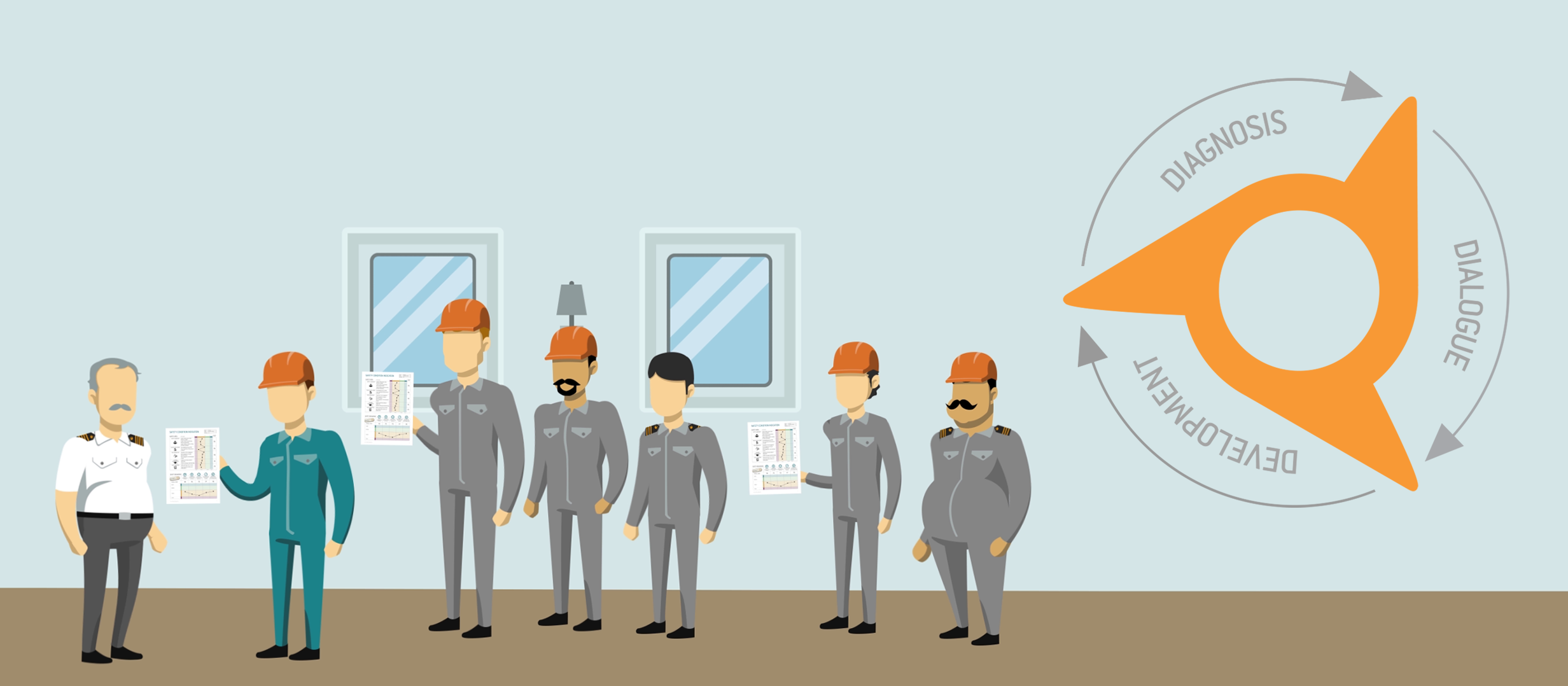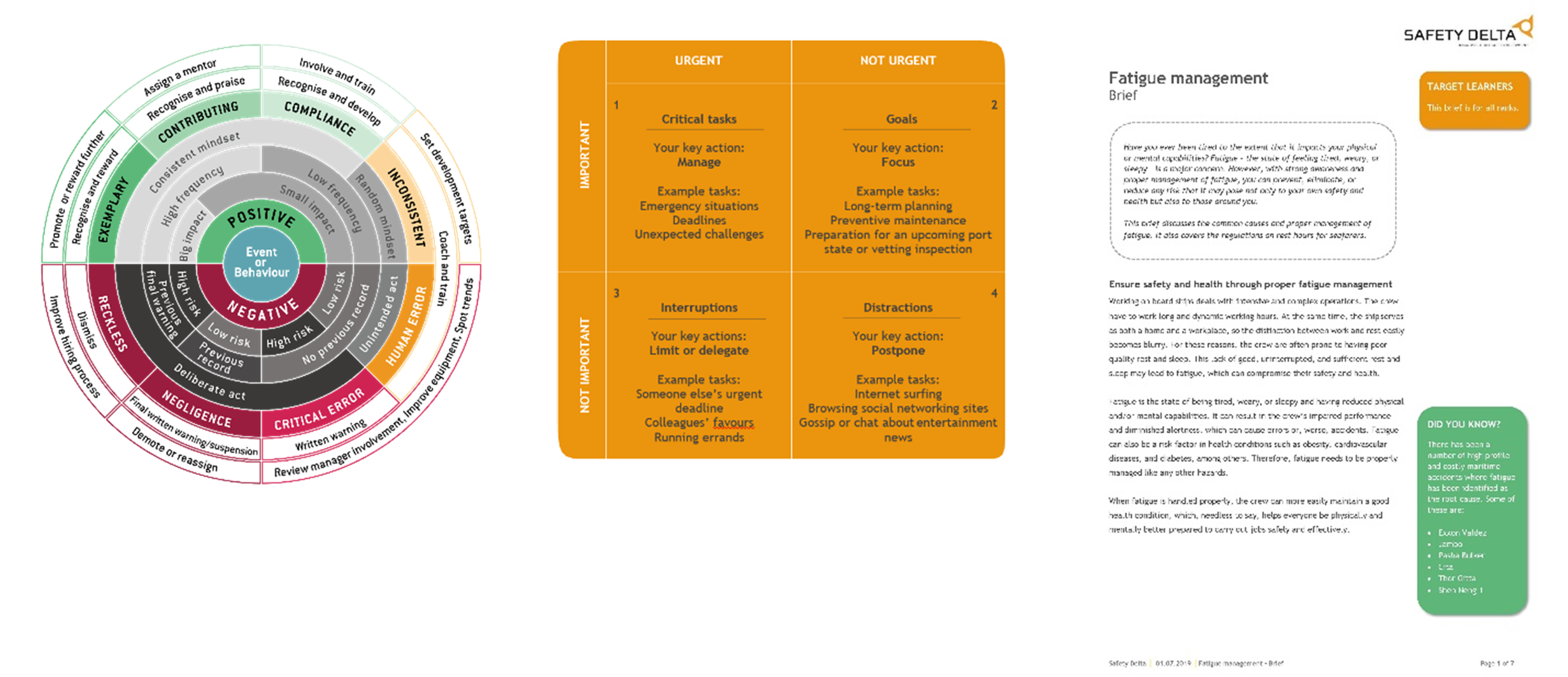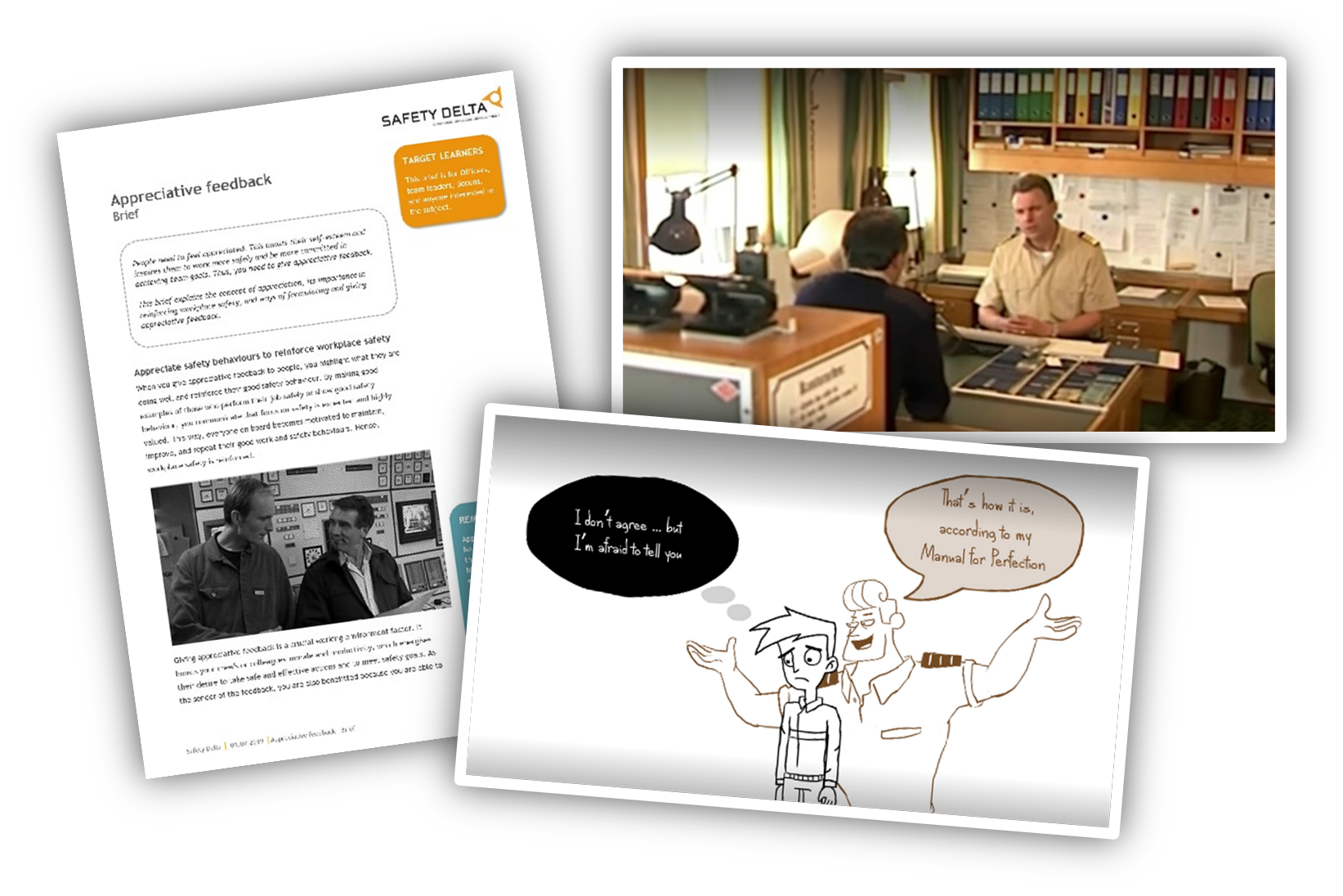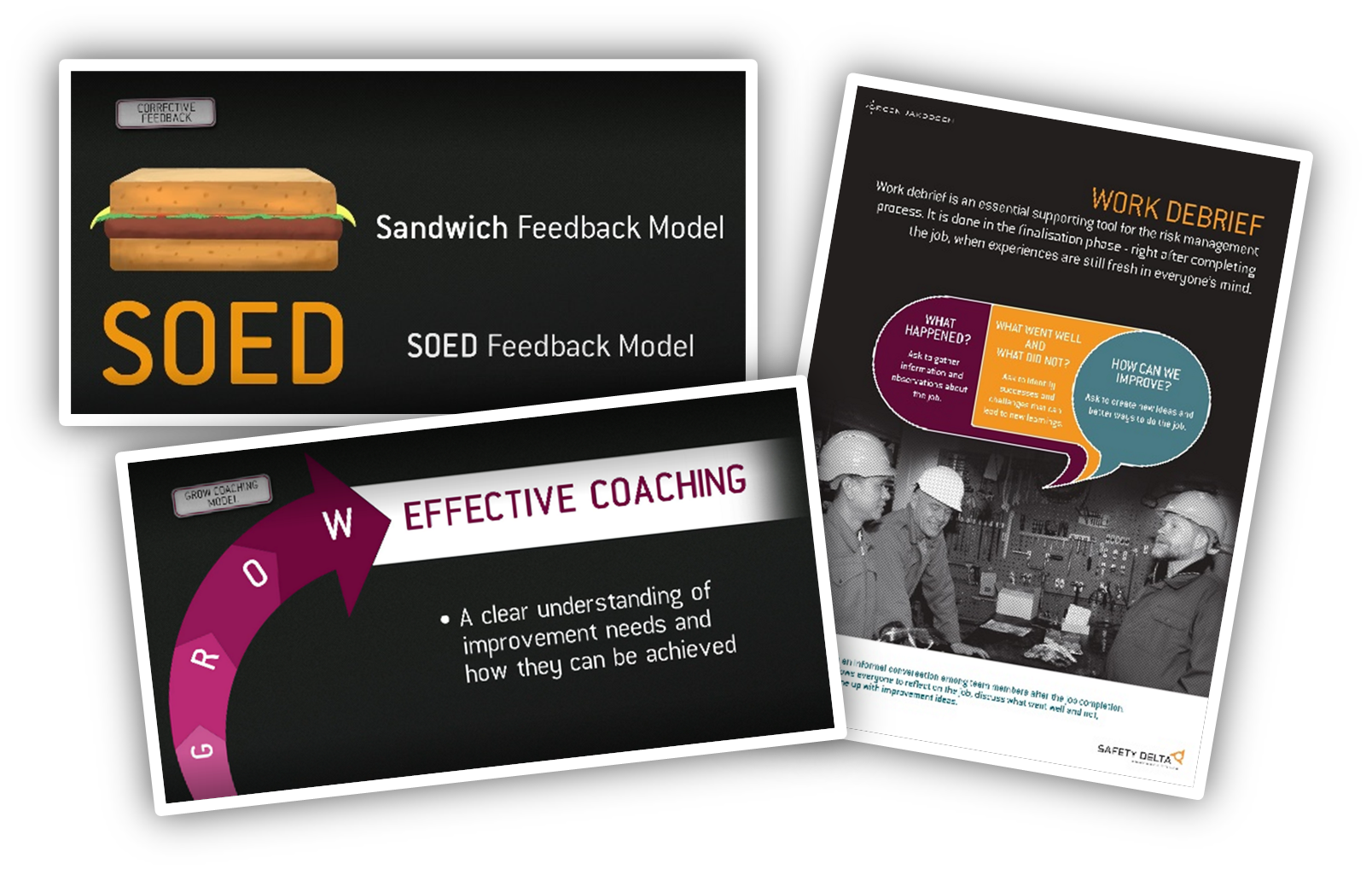SIRE 2.0, TMSA 3, DryBMS. Now that various industry requirements are leaning towards human factors management … is your company prepared?
With Safety Delta, we aim to bring you one step ahead in this aspect.
This is the second part of a series of articles published in Among us, the Safety Delta bulletin to Safety Delta clients (Read the first part here). We believe that any reader may profit from this insight, and that it will help acknowledge the actions that Safety Delta can promote to have a human factors approach and to be aligned with the OCIMF principles.
We go the extra (nautical) mile to help you comply and beyond
Managing human factors is about more than just fulfilling the requirements.
Safety Delta is designed in such a way that it makes human factors management an integrated part of your culture – it is part of every phase (preparation, execution, and finalisation) of every job and embedded in everyone’s behaviours and performance.
The Diagnosis, Dialogue, and Development stages give you opportunities and tools to continuously identify safety gaps, engage in active discussion, and improve your skills and behaviours so you can better manage human factors.

Be aligned with Human Factors principles
Below are the eight key principles that guide OCIMF’s approach to human factors. You will find out how Safety Delta helps you align with these principles, along with some practical tools that you can use. All of these can be found in the Safety Delta Learning Library, which is available to all Safety Delta users.
In order to give you an impression of what to find inside these modules, you will find links to a couple of them for you to browse or try free of charge.
1/ "People will make mistakes"
Faced with different and unexpected difficulties on board, both long-serving and newly hired crew can commit mistakes. We often see that bringing awareness of problems and critical work processes is an eye-opener even to experienced seafarers as they are easily ‘blinded’ by busy schedules at work or by overconfidence and complacency.
As a proactive approach to this, Safety Delta fosters a learning culture where people share safety-related information, and a backup culture where people serve as lookout for each other. The Safety Delta cycle also allows turning experiences into new learnings, and learnings into actions.
Some SDLL tools that you can use:
- 5 key actions for conducting an effective toolbox talk in the Toolbox Talk module
- ‘POV’ tool for making objective observations in the Observing Performance and Behaviour module
- Key points of Intervention and how to demonstrate them in the Safety I’s module

2/ “People’s actions are rarely malicious and usually make sense to them at the time’’
The crew often need to make sensible adjustments according to the demands of the circumstances. Reality on board will show itself, and it takes a mind to make judgements about it. Safety Delta helps the crew to make sound decisions – whether intuitive (instant) or analytic (thorough) – by considering and dealing with the criticality level, urgency, ideas from the team, and human factors.
Safety Delta also creates an open culture where people positively handle different suggested solutions to the challenge at hand, as well as a just culture where people do not fear to report errors because they value learning from these honest mistakes.
Some SDLL tools that you can use:
- ‘DE-C-I-DE’ steps for making systematic decisions in the Decision-making module
- Key actions for being open to different opinions in the Being Open To Different Opinions module
- ‘STAR’ ways to support a just culture in the Promoting a Just Culture module
3/ “Mistakes are typically due to conditions and systems that make work difficult’’
Mistakes usually occur in the interplay of human factors. If we are aware of these factors – the interaction of humans with each other, machines, and processes – we can more easily identify the gaps in an actual work situation.
Safety Delta fosters a just culture where mistakes are seen mainly as a result of unresolved issues such as poor work process, unreliable equipment, or bad management, instead of the crew who ‘made’ the mistake. It also provides ways to make the workplace a safer environment by addressing time pressure, fatigue and stress, mental health, and availability of appropriate PPE.
Relevant tools in the SDLL:
- Just Culture Quick Response Guide in the Promoting a Just Culture module
- Urgent-important matrix in the Handling Time Pressure module
- Fatigue management strategies in the Fatigue Management module

4/ “Understanding the condition in which mistakes happen helps us prevent or correct them’’
The people on board know the condition of their work better than anyone.
Safety Delta helps the crew to reflect on their perceptions of the work conditions and prevent mistakes before anything goes wrong.
The SDLL materials cover the following skills and behaviours to sharpen safety awareness and deal with emerging situations: situational awareness, hazard identification, seeking and sharing insight, intervention in unsafe situations or actions, and team communication.
Relevant tools in the SDLL:
- 3 steps of situational awareness in the Situational Awareness module
- Hazard wheel in the Hazard Identification module
- ‘STOP’ ways to stop unsafe acts in the Stopping Unsafe Acts module

5/ "People know the most about their work and are key to any solution"
Human error is cited as the leading cause of incidents at sea, but the truth is that people are still the centre of safety solutions. Safety Delta recognises this, hence we provide tools to develop the crew’s safety behaviours and skills so they can make appropriate judgements in safety-critical situations.
With Safety I’s™, we aim to nurture behaviours that support a proactive and reliable safety culture. Safety Delta also encourages teamwork and team communication, so that the crew – who are at the front line of jobs – can better address changes at work, new hazards and risks, job-related challenges, and other safety matters.
Relevant tools in the SDLL:
- Safety I’s behaviours in the Safety I’s module
- Key points of Insight and how to demonstrate them included in the Safety I’s module
- Key behaviours to overcome barriers to effective team communication in the Team communication module
6/ "Workplace, tools, and activities can be designed to reduce mistakes and manage risk better"
The workplace affects the crew members’ physical, mental, and emotional states, and in turn, their performance. Likewise, a single point of failure on any equipment may result in a hazardous situation. Thus, just as people’s skills should be developed, the workplace, tools, and activities on board should also be improved to help the crew eliminate or minimise risks.
Safety Delta fosters a safe and healthy environment on board so the crew can avoid diminished alertness and impaired performance. It also teaches about identifying improvement needs in the design and controls of equipment. As for activities, one way that Safety Delta helps is by shifting the common mistake of treating the risk assessment as just paperwork for compliance into treating it as a proactive process that must be done seriously by all crew members so they can better manage risks.
Relevant tools in the SDLL:
- Ways to create a safe and healthy environment in the Health and Well-being module
- 3 key points about critical equipment in the Critical Equipment module
- 3 basic steps of risk assessment in the Risk Assessment Practices module
7/ "Leaders contribute to shaping conditions that influence what people do"
Leaders shape the culture that drives crew behaviours – how they interact with one another and their environment, make decisions, perform tasks, and work towards a common goal. Safety Delta inspires leaders to actively drive and engage in safety performance as well as motivate and support the crew at all times, so they can influence them to develop and maintain safety as part of their mindset and actions.
The SDLL covers important leadership skills such as active listening (so leaders can understand and help address issues correctly), giving appreciative feedback (to motivate the crew to repeat good work and safety behaviours), giving clear instructions (to help in proper, safe, and smooth execution of jobs), and encouraging crew to speak up (to increase their involvement and engagement levels).
Relevant tools in the SDLL:
- 3 A’s in formulating and giving appreciative feedback in the Appreciative Feedback module
- Non-verbal and verbal responses used in active listening in the Active Listening module
- CIA Interpersonal Needs Theory in the Encouraging Crew to Speak Up module

8/ "It matters how leaders respond when things go wrong and that they take the opportunity to learn"
Leaders are in a good position to increase safety on board by motivating their crew to change their actions or behaviours and come up with ideas to make jobs safer. But how leaders do it spells the difference between a motivated crew and a defensive crew.
The SDLL covers topics that help leaders do it in proper and effective ways. Some examples are giving corrective feedback in a positive and structured way, providing coaching to help the crew improve particular safety skills, and conducting work debriefs to capture learning opportunities. The Safety Delta cycle also provides leaders with a clear picture of the areas they need to focus on, discuss, and develop.
Relevant tools in the SDLL:
- Sandwich and SOED feedback models in the Corrective Feedback module
- GROW coaching model in the GROW Coaching Model module
- 3 guide questions for effective work debriefs in the Work Debrief module

Imagine facing SIRE 2.0 and other human factors policies with confidence instead of stress.
Safety Delta helps you embed human factors management into your culture. This helps your crew develop confidence and successfully handle inspections, as safety becomes an integral part of “who they are” and “how they do things.”
As a safety culture tool, Safety Delta inspires you to take human factors management from compliance to commitment.
We are here to help you start the process.
Contact us for personal advice
Would you like us to call you?
... about Safety Delta


